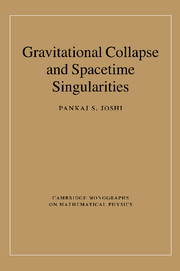
-
Select format
-
- Publisher:
- Cambridge University Press
- Publication date:
- 15 August 2009
- 13 December 2007
- ISBN:
- 9780511536274
- 9780521871044
- 9781107405363
- Dimensions:
- (247 x 174 mm)
- Weight & Pages:
- 0.652kg, 284 Pages
- Dimensions:
- (244 x 170 mm)
- Weight & Pages:
- 0.46kg, 284 Pages
You may already have access via personal or institutional login
Book description
Physical phenomena in astrophysics and cosmology involve gravitational collapse in a fundamental way. The final fate of a massive star when it collapses under its own gravity at the end of its life cycle is one of the most important questions in gravitation theory and relativistic astrophysics, and is the foundation of black hole physics. General relativity predicts that continual gravitational collapse gives rise to a space-time singularity. Quantum gravity may take over in such regimes to resolve the classical space-time singularity. This book investigates these issues, and shows how the visible ultra-dense regions arise naturally and generically as an outcome of dynamical gravitational collapse. It will be of interest to graduate students and academic researchers in gravitation physics, fundamental physics, astrophysics, and cosmology. It includes a detailed review of research into gravitational collapse, and several examples of collapse models are investigated in detail.
Reviews
'… beautifully produced …'
Source: The Observatory
'… provides a useful introduction to aspects of gravitational collapse and the development of singularities. It would provide a useful starting point to either a graduate student already familiar with general relativity, or an already active researcher in a different area of relativity, who wishes to investigate recent work on gravitational collapse.'
Source: Mathematical Reviews
‘This monograph … should be useful to students and mature researchers alike. It focuses especially on the issue of 'cosmic censorship': what conditions, in mathematical models of collapse, can lead to naked singularities, what are the singularities' properties, and how might the laws of loop quantum gravity modify singularity formation … rich insights flow from this book's analyses, and its summaries of the relevant literature are particularly useful. Anyone interested in gravitational collapse will find this book's insights and literature summaries of great value.’
Kip S. Thorne - Feynman Professor of Theoretical Physics, Emeritus, California Institute of Technology
‘Gravitational collapse of massive objects is still a major unsolved problem in general relativity at the present time. Collapse of massive objects may lead to a black hole, but may also lead to a naked singularity. Both are possible, as the conjectured 'cosmic censorship' that would cloak naked singularities does not always hold; it is an important topic in gravitational physics to determine which will occur under what circumstances. In this well reasoned book, Dr Joshi gives a careful survey of the general relativity aspects of this problem, emphasizing how it remains unsolved to the present day. The book will provide a good springboard for those wishing to tackle this important problem.’
George Ellis - University of Cape Town
Contents
Metrics
Altmetric attention score
Full text views
Full text views help Loading metrics...
Loading metrics...
* Views captured on Cambridge Core between #date#. This data will be updated every 24 hours.
Usage data cannot currently be displayed.
Accessibility standard: Unknown
Why this information is here
This section outlines the accessibility features of this content - including support for screen readers, full keyboard navigation and high-contrast display options. This may not be relevant for you.
Accessibility Information
Accessibility compliance for the PDF of this book is currently unknown and may be updated in the future.


